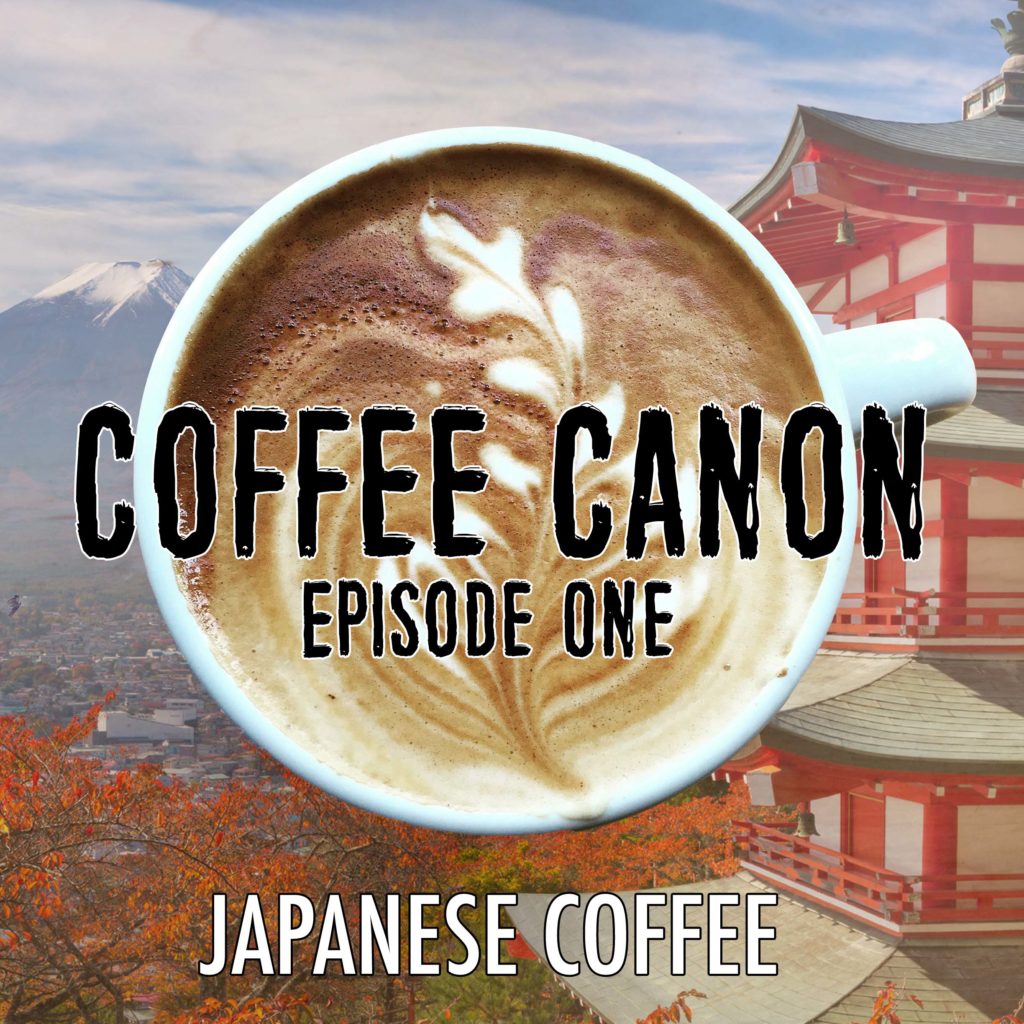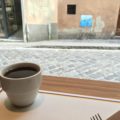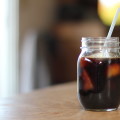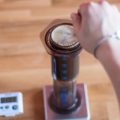In this first episode of Coffee Canon, we take a look at Japan: a culture rich with history and tradition. Today, Japanese people love coffee – they’ve invented entire brew methods that the rest of the world adopted – but it wasn’t always this way. We study how and why Japan went from rejecting coffee outright, to embracing it completely. We discuss the people, companies, and timeline that pushed Japan to becoming a leader in specialty coffee – and we hear from some coffee experts along the way.
Enjoy the episode, and feel free to check out the sources below if you want to read more. To continue the discussion, hit me up on Twitter or Instagram.
Colin
Episode One Sources:
- A commentary on coffee history in Japan: https://www.tofugu.com/japan/japanese-coffee/
- A paper discussing Japan’s coffee history, along with imports and sales of coffee: http://coffee.ajca.or.jp/wp-content/uploads/2012/07/coffee_market_in_japan.pdf
- Wikipedia Articles:
- https://en.wikipedia.org/wiki/History_of_coffee#Japan
- https://en.wikipedia.org/wiki/Kissaten
- https://ja.wikipedia.org/wiki/ダッチ·コーヒー (with help from Google Translate)
- Specialty coffee in Japan: http://boutiquejapan.com/coffee-in-japan/
- A comparison between third wave coffee and Japanese Kissaten: https://www.perfectdailygrind.com/2015/09/third-wave-coffee-japanese-kissaten-more-similar-than-you-might-think/
- Citizens of Humanity James Freeman interview: https://mag.citizensofhumanity.com/blog/2016/09/28/james-freeman-blue-bottle-cofffee/
- History of the Hario v60: https://www.perfectdailygrind.com/2015/07/hario-v60-the-history-brewing-guide/
- Japanese Iced Coffee
- Thread where Peter Giuliano explains why he calls it “Japanese Iced Coffee:” http://www.coffeed.com/viewtopic.php?f=17&t=3950
- Peter Giuliano makes his case for Japanese Iced Coffee over cold-brew: http://petergiuliano.tumblr.com/post/22177089634/why-you-should-stop-cold-brewing-and-use-the
- Fresh Cup Magazine article by Peter Giuliano, “Discovering Japanese Iced Coffee:” https://www.freshcup.com/discovering-japanese-iced-coffee/
- Interview with Hidetaka Hayashi: http://www.beanscenemag.com.au/articles/view/hidetaka-hayashis-japanese-journey
- Music:
- “Blues Angeline” by Lobo Loco – FreeMusicArchive.org
- “Passing through the Basin” by Lobo Loco – FreeMusicArchive.org
Episode One Transcript:
There is perhaps no better place to start talking about coffee’s journey from obscure plant to modern necessity than Japan. In many ways, Japan is a case-study in how coffee can spread from small import to national obsession in just a few centuries. Japan isn’t the only country that experienced this, but its story is unique in that for about two hundred years and of its own leaders’ volition, Japan was cut off from the rest of the world. Today, Japan is a leader in the specialty coffee world – it’s home to companies that make equipment used in barista competitions and it’s the source of brew methods that people all over the world use to make their coffee every day. How did this happen?
I’m Colin Mansfield, and welcome to Coffee Canon.
To understand Japan’s coffee history, you first have to understand Sakoku: Japan’s period of national isolation. This was the time period where relations and trade between Japan and other countries were severely limited – foreigners weren’t allowed in, and citizens weren’t allowed out. I’m only giving a partial history due to the complexity involved in Sakoku, but it should provide enough context for our purposes here. Sakoku began from 1633-1639 and continued for the next two centuries, ending in 1853 after the famous treaties with Commodore Perry.
Some believe the rationale behind Sakoku was religion-based: colonials from Spain and Portugal had increased Catholic conversions in southern Japan – this may have been seen as a threat to the stability of the shogunate.
Other scholars believe competing religious ideologies to be only part of a larger political reality. Regardless, Spain and Portugal were seen as genuine threats to the Japanese ruling class.
While social, religious, and political factors provide the backdrop for Sakoku, the trigger was the Shimabara Rebellion of 1637-1638. This uprising consisted of 40,000 mostly Christian peasants, and as is true of many rebellions, was due to drastically increased taxes and religions persecution. The shogunate dispatched over 125,000 troops to quell the uprising and besieged the rebels at Hara Castle. Eventually, the rebels fell. The Catholic leader of the uprising, Amakusa Shiro, was beheaded and the prohibition of Christianity became strictly enforced under penalty of death. Additionally, all contact with the outside world, including trading, became strictly regulated by the shogunate.
If you want to know more about this dark period in Japanese history, check out the film Silence that came out last year. Directed by Martin Scorsese and starring Andrew Garfield and Liam Neeson, this film dives headlong into 17th century Japan and the dangers Catholics and Christians faced – it’s really an amazing film.
It is under this backdrop that coffee first made its way to Japan. The year that this first happened depends on which accounts you read – some say it was as early as 1609, while most estimate it to be after Sakoku was established, towards the end of the 18th century. Everyone agrees, however, on who first brought coffee to Japan – the Dutch. The Dutch, in fact, pop up often in coffee history; we have them to thank for most of the big moves in coffee’s spread around the world.
Apparently Japanese people didn’t to the drink at first – they felt coffee was bitter and unpleasant, especially compared to tea. According to some sources, the tiny island of Dejima in Nagasaki had a small coffee culture in these early years due to this being the only area in Japan where European merchants were allowed entrance.
The next big date in Japanese coffee history falls after the end of Sakoku, in the year 1888 when the first European-style coffee shop opened in Tokyo. It was called Kahi Chakan, but it only lasted about 4 years before closing due to a lack of interest from Japanese consumers. Still, coffee imports increased and demand began meeting supply. In the early 1900s coffeehouses finally began experiencing success, and by 1930 there were over 30,000 coffee shops across Japan. In 1937 imports peaked at 140,000 bags of coffee beans. Then, World War I and World War II happened. Coffee availability in the wartime and post wartime periods dropped to nearly 0, but at the conclusion of the wars they again rose to normal numbers.
The introduction of instant coffee had a profound impact on European and American consumption of coffee during and after both World Wars. In Japan, it was no different. The availability and abundance of freeze-dried coffee and canned coffee in the post-WW2 era was making the entire world into caffeine junkies, including the Japanese. This created a market where people were willing to spend money, and franchises quickly picked up on it. Doutor Coffee was Japan’s first large-scale coffee franchise and began opening stores across the country starting in 1980. In the mid 1990s Starbucks branched into the Japanese market as well and quickly expanded across the entire country. Today there are more than 1000 Starbucks locations in Japan.
More recently, McDonalds impacted Japanese coffee culture in a big way. They established standalone “McCafe” shops in 2007, and in just 7 years had spread to nearly 100 locations. This is in addition to the 3,000 standard McDonalds locations. The standalone McCafe locations try to appeal to the more sophisticated coffee drinkers with a pricier menu and higher grade of coffee. Some locations even have the ability to deliver coffee.
Besides huge coffee franchises like Starbucks, Tullys, Doutor, and McDonalds, Japan has a rich history of smaller, local shops called kissaten. Kissaten literally translates to “tea-drinking shop” and was originally a place for business people and the older generations to gather for light meals and discussions. As coffee began to be standard in Japanese culture, kissaten evolved and began to serve the beverage as well. They are a popular place for breakfast, serving thick toast, eggs, and a piece of ham or bacon along with a morning cup of coffee. In Japanese culture, kissaten are distinctly different from cafes. While cafes usually feature a more trendy and modern look and feel, kissaten are older and more classically furnished. Another huge distinction is in tobacco use. Smoking is still a large part of Japanese culture, and kissaten are havens for people to sit down and light up a cigarette to accompany their cup of coffee. Many larger cafes and coffee chains prohibit smoking.
It’s difficult to nail down exactly when specialty coffee began becoming popular in Japan, but it’s important to note that at least some elements of specialty coffee culture as we know it today were actually inspired by Japan. James Freeman, the founder of Blue Bottle Coffee – a popular, large specialty coffee chain – visited Japan as a teenager. In an interview with Citizens of Humanity he said that it “blew me away.” He went on to say, “I’ve really been inspired by Japanese coffee houses, called kissaten. They’re dowdy and unfashionable, but they’re deeply personal.” He also discussed the Japanese concept of kodawari, or the devotion to even the most mundane details in the pursuit of excellence. “All of these kissaten have a deep kodawari” he said.
This idea of kodawari really shines through in Japanese-made specialty coffee equipment – most notably, the Hario v60 manual coffee brewer. The Hario v60 is a fundamentally important brew device in specialty coffee circles. It’s more touchy to brew with than a Chemex or similar drip cones – altering small details can change an entire cup of coffee. In that sense, paying attention to mundane details is essential.
Hario, the company that created and manufactures the v60, was founded in Tokyo in 1921. It started by producing and selling glass products to be used for physical and chemical purposes. After nearly 30 years of research, they produced an environmentally-friendly heatproof glass. In 1949 Hario launched a glass coffee syphon as their first home product, followed by a cloth filter version in 1957. In the early 2000s Hario launched the v60 – its name means “vector 60,” referencing the 60 degree angle of the cone. The v60 was first launched with glass and ceramic variants, but now has plastic, metal, and copper variations. The copper version, while expensive, has awesome thermal conductivity resulting in a better extracted cup of coffee. The v60 is used everywhere: specialty coffee competitions, coffee shops, and in homes around the world. I use my v60 for both hot and iced coffee nearly every day.
2015 was a big year for specialty coffee in Japan. Blue Bottle Coffee opened its flagship shop in Tokyo to much media fanfare, resulting in 2-hour lines just to get in the door. In an article from PerfectDailyGrind.com the author references several other foreign-based specialty coffee shops as being successful in Japan; namely, Oslo’s Fuglen and New Zealand’s Allpress Espresso. These quality shops have played a big role in cementing the demand for third wave coffee in Japan.
An ongoing discussion in the Japanese coffee scene is whether specialty shops and kissaten can co-exist. Kissaten, it seems, are beginning to lose popularity as older generations die and younger coffee drinkers look for a more modern take. Some people seem to think that the more local specialty coffee shops have taken a page out of kissatens’ book with a focus on details and a more relaxed, classic Japanese aesthetic. Others say that kissaten will inevitably die, making way for the next generation to fill the void. While I’m certainly no expert on Japanese culture, it seems to me that their cultural focus on details and doing things well opens the door for kissaten and specialty shops to coexist – but it remains to be seen if the market will support that. If people pick one place to get their coffee from, where will they choose? Only time will tell.
There’s one aspect of Japanese coffee culture that we haven’t discussed yet, and that’s Japanese Iced Coffee, sometimes called flash brewed coffee. The history of iced coffee in Japan isn’t completely clear – but what sets the method apart from other iced-coffee brewing techniques is. Japanese Iced Coffee uses the same principles and methods for brewing hot coffee, but then replaces 50-60% of the hot water for ice. Basically, you brew hot coffee as you normally would, but the hot liquid is immediately cooled when it comes into contact with the ice. Then, as the ice melts, the coffee remains properly extracted. The science behind Japanese Iced Coffee is solid: when you brew hot coffee, the amazing smells that come off of the fresh cup are actually aromatics that are escaping the beverage. You get to smell them while you brew and for a short time after, but the actual cup loses these aromatic compounds. By immediately and quickly cooling down a cup of brewed coffee, these aromatics get trapped in the beverage. When you’re ready to drink it, these smells can escape into your nasal cavity, combining the taste of your iced coffee with amazing smells that might otherwise have been lost. This is one reason why Japanese Iced Coffee captures the dramatic, fruity, and acidic notes that other methods like cold brew have a harder time holding onto.
Japanese Iced Coffee has probably been practiced in Japan for a long, long time. It’s introduction into the U.S., however, is more recent – by my research I estimate Japanese Coffee started being recognized as a unique brewing method about 10 years ago, and almost entirely because of one important figure in U.S. Specialty Coffee: Peter Giuliano. Giuliano was the coffee director and co-owner of Counter Culture Coffee out of North Carolina. Since 2012 he’s been director of the Specialty Coffee Symposium for the Specialty Coffee Association of America. Peter Giuliano is one of the people in the coffee world where when he talks, people listen.
At least since 2009, and probably earlier, Peter Giuliano has been preaching the good news of Japanese Iced Coffee to just about anyone who will listen. He discussed it with a journalist from Imbibe Magazine for an article in 2009, he wrote about it in his blog, Pax Coffea, in 2012, and he wrote an article about it for Fresh Cup Magazine in 2014 to name just a few instances over the years. In the Fresh Cup article, Giuliano explains a little bit about why he’s so passionate.
“In 1994, I visited Japan for the first time. There, iced coffee (called aisu kohi) was ubiquitous. Every pastry place served iced coffee, in a tall chimney glass with a tiny pitcher of liquid sugar on the side. Japanese coffee drinkers would sip it in the afternoon, chatting and eating sweets. I ordered one just to explore. I was expecting the battery-acid flavors I’d become accustomed to back home, but instead I discovered a completely different drink—clear and crisp, multilayered and transparent, refreshing and complex. Aisu kohi opened my eyes.”
In the piece he wrote on his blog titled, “Why you should stop cold-brewing, and use the Japanese Iced Coffee Method.” he explains further saying, “I puzzled over it for years. Finally, I developed a relationship with Hidetaka Hayashi, who is a kind of specialty coffee idol in Japan. One of the first questions I asked Mr. Hayashi was how iced coffee was different in Japan. He taught me a lot over the years, but the thing I figured out was this: many of the iced coffee processes I liked the best brewed coffee hot, then chilled the coffee INSTANTLY by brewing right onto ice. The dilution from the melting of the ice can be taken account in the brew recipe, leading to proper strength and maximum happiness.”
Calling Hidetaka Hayashi a specialty coffee idol is actually putting it modestly – he’s credit as being the individual who brought true specialty coffee to Japan in the first place. He’s worked in bringing quality beans to Japan since the early 1960s. In one interview I found, Hidetaka gives insight into why the Japanese prefer the brewing methods they use. He said that in the 10-year period between 1963-1972 “Japan was considered a new market, therefore we were given very low quality coffee at very low prices, far lower than what traditional markets or Annex-A countries paid, and with no guarantee of quality.” Japan was given low-altitude, low-quality coffee, and due to this Japanese people looked for ways to get the most out of their sub-par beans. They turned to using paper filters for pour-over and siphon brewing methods – both methods are still mainstays in Japanese coffee culture.
At one point in July 2015, Peter Giuliano addressed the name – “Japanese Iced Coffee” – by posting a short thread on coffee forum coffeed.com. It’s actually really interesting to take a look at, several big players in the specialty coffee world like Nick Cho from Wrecking Ball and Jay Cunningham from Intelligentsia stopped by to write their opinion. Giuliano wrote, “I think I understand the reticence to call it “Japanese” iced coffee. I’ve had people tell me it seems fake, or misleadingly exotic, or inauthentic, kind of like Chinese Chicken Salad or English Muffins. I don’t agree, and here’s why:” he goes on to list three main reasons: first, he thinks its important to recognize and acknowledge the origin of the technique. Second, he believes that one of the great things about food is exploring cultural diversity. Third and finally, he doesn’t think there’s a better term for Japanese Iced Coffee. As he put it, “ “Flash brewing” sounds to me like someone is opening a raincoat just before making coffee.”
In recent years cold brewed coffee has gone mainstream – so to speak – with Starbucks and Dunkin Donuts offering their versions for sale during summer months. Cold brew stands diametrically opposed to Japanese Iced Coffee – it steeps coffee grounds in cold water for extended time periods to try and capture the maximum amount of flavor compounds in the final product. The problem, as we looked at earlier, are those aromatics – cold brew just has no way to get them into the drink. For this reason, while cold brew seems to get more popular with the masses each year, Japanese Iced Coffee is typically hailed as the tastier, more captivating iced coffee by specialty coffee enthusiasts. And here’s another interesting fact about cold brew – in Japan, the term they use to refer to it literally means, “Dutch Coffee” despite the fact that there’s really no connection between the method itself or cold-brew equipment with the Netherlands. If there’s one name that needs to change, it’s not Japanese Iced Coffee, it’s this one.
Like all coffee culture, Japanese coffee culture follows the path of the country’s history. Over time, coffee in Japan has shown itself to be resilient and able to bounce back after cultural shifts and entire wars. While Japanese people were at first resistant to coffee’s bitter taste, today they are one of the world’s largest coffee consumers. You can find instant coffee on every corner in places like Tokyo, along with coffee chains. Kissaten, while once a ritual mainstay in Japanese culture, have begun to give way while specialty coffee shops are flourishing. Where in 1888 the first coffee shop in Tokyo closed after just four years, today Blue Bottle has an incredibly successful flagship store. Japan is the home of world-class businesses who manufacture excellent coffee equipment. And beyond physical products, Japan has forever influenced global coffee culture by inventing and perfecting the Japanese Iced Coffee brew method. Today, Japan is undoubtedly a leader in the world of coffee.
Thanks for listening to Coffee Canon. I’m your host Colin Mansfield, and I hope you enjoyed this first episode. If you want to take a look at any of the sources I used to write this episode, head over to the blog post on BoiseCoffee.org. If you’re interested in getting previews for upcoming future episodes and other premium content, join the Coffee Canon email list. Just go to BoiseCoffee.org/coffeecanon and enter your information.
Coffee Canon will have a new episode every two weeks. Until then, go find a cup of Japanese Iced Coffee to enjoy before it gets too cold outside. Don’t worry, Pumpkin Spice Lattes will be here all autumn.
Podcast: Play in new window | Download
Subscribe: Apple Podcasts | Android | Stitcher | RSS





Hey man! I’m really curious about Flash Brewed coffee – Would a french press work? just brew it with half the water and pour it over ice that makes up the other half?
Hey Steven! I wouldn’t recommend using a French Press for Japanese Iced Coffee, mainly because of the filter. Metal mesh filters don’t typically produce the same crisp/clean notes that you’ll get from paper filters. This is mainly because they let a lot of coffee oils into the end product. A paper filter drip cone (like the Chemex, v60, or similar products) is the best way to let the bright, clear flavors shine through – you get the flavor compounds, but without oils. With that said, experimentation never hurts – if you end up trying French Pressed Japanese Iced Coffee I’d be interested in knowing the results. Let me know!
Hey yeah I tried it with a french press and I get what you mean about the coffee keeping the aromatics, I will at some point need to break down and get a Chemex. I think i was a little too impatient though in the morning, or didn’t measure the water right, but I poured it before all the ice melted haha, I still liked it though!
thanks man!